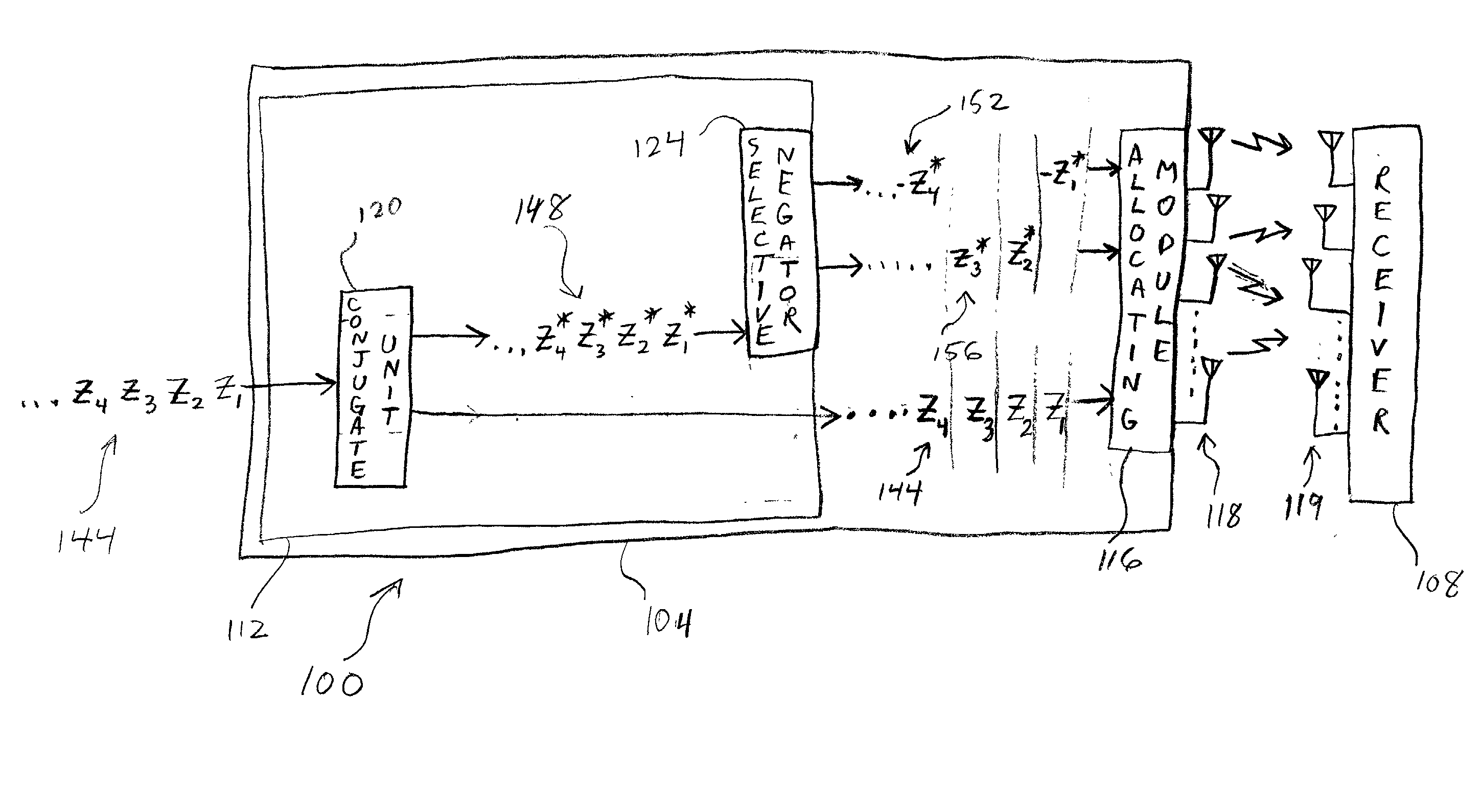ISI-robust slot formats for non-orthogonal-based space-time block codes
a slot format and block code technology, applied in the field of isirobust slot formats for non-orthogonal-based spacetime block codes, can solve the problems of delay spread, interference with the ability of the receiver, and difficulty in detecting individual arriving symbols at the receiver
- Summary
- Abstract
- Description
- Claims
- Application Information
AI Technical Summary
Problems solved by technology
Method used
Image
Examples
first embodiment
[0027] FIG. 2 shows an exemplary slot 200 in accordance with the present invention. The slot 200 is shown as a sum of two matrices. The symbols "x" in the second matrix are of the form "{tilde over (x)}" to distinguish their respective modes of transmission. This difference between the modes aids the receiver in distinguishing between the component symbols of the added entries.
[0028] Typically, complex symbols are formatted for transmission in accordance with a conventional complex modulation scheme such as QPSK (quadrature phase shift key), 16-QAM (16-point quadrature amplitude modulation), 8-PSK (8-point phase shift key), 4-PSK (4-point phase shift key), etc., which represents a symbol by a point in a two-dimensional constellation. It should be noted that the intended scope of the present invention includes any modulation scheme for formatting complex symbols for transmission.
[0029] In QPSK, for example, a constellation consists of four points in the complex plane, e.g., {(1+j) / {s...
second embodiment
[0042] An exemplary slot 300 in accordance with the invention is shown in FIG. 3. As is the case for slot 200, the length of slot 300 is 2n+{number of pilot symbols per slot per transmitter} symbol periods. Slot 300, like slot 200, has a first symbol period 310, a second symbol period 320, a last symbol period 330, a next to last symbol period 340 and pilot symbol period(s) 250.
[0043] Each NOBSTBC, i.e., each matrix consisting of the first and last columns 310 and 330 only, or of the second and next to last columns 320 and 340 only, and so on, is formed by vertically stacking, for concurrent application, a predetermined number of temporally consecutive 2.times.2 Alamouti codes, so that the Alamouti codes each define the transmission scheme of respective, added transmitting antennas. With the predetermined number set equal to two, the last two rows in slot 300 correspond to a third and a fourth transmitting antenna. As is the case in the first embodiment, in forming the NOBSTBC's the...
third embodiment
[0050] There are many variations of the The orthogonal based constituent matrices in the four checker squares may be transposed, negated, conjugated or permuted, or modified by any combination of these. As one example, the lower, right-hand Alamouti code (in the lower, right-hand checker square) of the NOBSTBC may have its rows or columns exchanged. As applied to matrix CNOBSTBC in equation (6) above, if the rows of its lower, right-hand constituent matrix are reversed, CNOBSTBC is formatted instead as: 8 C N O B S TB C ' = [ z 1 - z 2 * z 3 - z 4 * z 2 z 1 * z 4 z 3 * z 3 - z 4 * z 2 z 1 * z 4 z 3 * z 1 - z 2 * ] ( 7 )
[0051] The three techniques of the above-described three embodiments, i.e. mathematical combining, simple stacking and checkerboard stacking, respectively, may be concurrently used in any combination. For example, NOBSTBC's, each formed by checkerboard stacking, may be simply stacked. Thus, if the checkerboard stacking forms a 4.times.4 NOBSTBC from two 2.times.2 Ala...
PUM
 Login to View More
Login to View More Abstract
Description
Claims
Application Information
 Login to View More
Login to View More - R&D
- Intellectual Property
- Life Sciences
- Materials
- Tech Scout
- Unparalleled Data Quality
- Higher Quality Content
- 60% Fewer Hallucinations
Browse by: Latest US Patents, China's latest patents, Technical Efficacy Thesaurus, Application Domain, Technology Topic, Popular Technical Reports.
© 2025 PatSnap. All rights reserved.Legal|Privacy policy|Modern Slavery Act Transparency Statement|Sitemap|About US| Contact US: help@patsnap.com



